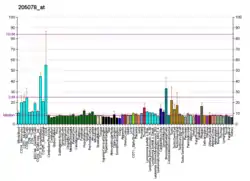| PIGF | |||||||||||||||||||||||||||||||||||||||||||||||||||
|---|---|---|---|---|---|---|---|---|---|---|---|---|---|---|---|---|---|---|---|---|---|---|---|---|---|---|---|---|---|---|---|---|---|---|---|---|---|---|---|---|---|---|---|---|---|---|---|---|---|---|---|
| Identifiers | |||||||||||||||||||||||||||||||||||||||||||||||||||
| Aliases | PIGF, phosphatidylinositol glycan anchor biosynthesis class F, OORS | ||||||||||||||||||||||||||||||||||||||||||||||||||
| External IDs | OMIM: 600153 MGI: 99462 HomoloGene: 31103 GeneCards: PIGF | ||||||||||||||||||||||||||||||||||||||||||||||||||
| |||||||||||||||||||||||||||||||||||||||||||||||||||
| |||||||||||||||||||||||||||||||||||||||||||||||||||
| |||||||||||||||||||||||||||||||||||||||||||||||||||
| |||||||||||||||||||||||||||||||||||||||||||||||||||
| |||||||||||||||||||||||||||||||||||||||||||||||||||
| Wikidata | |||||||||||||||||||||||||||||||||||||||||||||||||||
| |||||||||||||||||||||||||||||||||||||||||||||||||||
Phosphatidylinositol-glycan biosynthesis class F protein is a protein that in humans is encoded by the PIGF gene.[5][6][7]
Function
This gene encodes a protein that is involved in glycosylphosphatidylinositol (GPI)-anchor biosynthesis. The GPI-anchor is a glycolipid which contains three mannose molecules in its core backbone. The GPI-anchor is found on many blood cells and serves to anchor proteins to the cell surface. This protein and another GPI synthesis protein, PIGO, function in the transfer of ethanolaminephosphate (EtNP) to the third mannose in GPI. At least two alternatively spliced transcripts encoding distinct isoforms have been found for this gene.[7]
See also
References
- 1 2 3 GRCh38: Ensembl release 89: ENSG00000151665 - Ensembl, May 2017
- 1 2 3 GRCm38: Ensembl release 89: ENSMUSG00000024145 - Ensembl, May 2017
- ↑ "Human PubMed Reference:". National Center for Biotechnology Information, U.S. National Library of Medicine.
- ↑ "Mouse PubMed Reference:". National Center for Biotechnology Information, U.S. National Library of Medicine.
- ↑ Ohishi K, Inoue N, Endo Y, Fujita T, Takeda J, Kinoshita T (Oct 1995). "Structure and chromosomal localization of the GPI-anchor synthesis gene PIGF and its pseudogene psi PIGF". Genomics. 29 (3): 804–807. doi:10.1006/geno.1995.9929. PMID 8575782.
- ↑ Inoue N, Kinoshita T, Orii T, Takeda J (Apr 1993). "Cloning of a human gene, PIG-F, a component of glycosylphosphatidylinositol anchor biosynthesis, by a novel expression cloning strategy". The Journal of Biological Chemistry. 268 (10): 6882–6885. doi:10.1016/S0021-9258(18)53122-7. PMID 8463218.
- 1 2 "Entrez Gene: PIGF phosphatidylinositol glycan anchor biosynthesis, class F".
Further reading
- Kinoshita T, Takahashi M, Inoue N, Miyata T, Takeda J (Feb 1994). "Expression cloning of genes for GPI-anchor biosynthesis". Brazilian Journal of Medical and Biological Research. 27 (2): 127–132. PMID 8081220.
- Hong Y, Maeda Y, Watanabe R, Inoue N, Ohishi K, Kinoshita T (Jul 2000). "Requirement of PIG-F and PIG-O for transferring phosphoethanolamine to the third mannose in glycosylphosphatidylinositol". The Journal of Biological Chemistry. 275 (27): 20911–20919. doi:10.1074/jbc.M001913200. PMID 10781593.
- Shishioh N, Hong Y, Ohishi K, Ashida H, Maeda Y, Kinoshita T (Mar 2005). "GPI7 is the second partner of PIG-F and involved in modification of glycosylphosphatidylinositol". The Journal of Biological Chemistry. 280 (10): 9728–9734. doi:10.1074/jbc.M413755200. PMID 15632136.
- Li W, Shen W, Gill R, Corbly A, Jones B, Belagaje R, Zhang Y, Tang S, Chen Y, Zhai Y, Wang G, Wagle A, Hui K, Westmore M, Hanson J, Chen YF, Simons M, Singh J (May 2006). "High-resolution quantitative computed tomography demonstrating selective enhancement of medium-size collaterals by placental growth factor-1 in the mouse ischemic hindlimb". Circulation. 113 (20): 2445–2453. doi:10.1161/CIRCULATIONAHA.105.586818. PMID 16702473.
- Yano K, Liaw PC, Mullington JM, Shih SC, Okada H, Bodyak N, Kang PM, Toltl L, Belikoff B, Buras J, Simms BT, Mizgerd JP, Carmeliet P, Karumanchi SA, Aird WC (Jun 2006). "Vascular endothelial growth factor is an important determinant of sepsis morbidity and mortality" (PDF). The Journal of Experimental Medicine. 203 (6): 1447–1458. doi:10.1084/jem.20060375. PMC 2118329. PMID 16702604.
- Zheng Y, Murakami M, Takahashi H, Yamauchi M, Kiba A, Yamaguchi S, Yabana N, Alitalo K, Shibuya M (Sep 2006). "Chimeric VEGF-E(NZ7)/PlGF promotes angiogenesis via VEGFR-2 without significant enhancement of vascular permeability and inflammation". Arteriosclerosis, Thrombosis, and Vascular Biology. 26 (9): 2019–2026. doi:10.1161/01.ATV.0000233336.53574.a1. PMID 16794222.
- Mohammed KA, Nasreen N, Tepper RS, Antony VB (Feb 2007). "Cyclic stretch induces PlGF expression in bronchial airway epithelial cells via nitric oxide release". American Journal of Physiology. Lung Cellular and Molecular Physiology. 292 (2): L559–566. doi:10.1152/ajplung.00075.2006. PMID 17028267.
This article is issued from Wikipedia. The text is licensed under Creative Commons - Attribution - Sharealike. Additional terms may apply for the media files.





